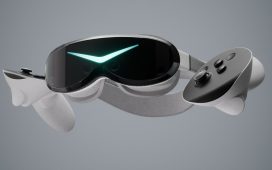When Meta first revealed the Quest Pro it seemed like the company had taken the much-loved Quest 2, upgraded and enhanced it in various ways and then aimed it squarely at businesses, much like HTC had done with the Vive Focus 3.
With upgrades that include the “sleekest form factor yet”, a display that offers 37 per cent more pixels per inch than the Quest 2, a Qualcomm Snapdragon XR2+ processor and more, the Quest Pro certainly seems like a great upgrade. But is it suitable for the average consumer as well? We’ve been testing it out in various ways to find out.

Meta
Meta Quest Pro
Editor’s Choice
Meta Quest Pro is a powerful standalone VR headset that also works with your PC in various ways.
- Superb visuals and sound
- Excellent inside out tracking
- Comfortable fit
- Flexible uses
- Hefty price tag
- Fiddly base station
A premium standalone VR headset with promise
- 2 x LCD panels (1800 x 1920 pixels per eye) with local dimming backlight
- Field of view (claimed): 106° horizontal × 96° vertical
- 55 to 75 IPD range
- Wi-Fi 6E-enabled, Bluetooth 5.2, PC support with Oculus Link and Air Link
We’ve been using the Meta Quest 2 for a long time so we went into using the Quest Pro expecting to feel a significant upgrade. After all, Meta claims the Quest Pro has four times the resolution and 50 per cent more processing power than the Quest 2. So in theory it should be something special.
The Quest Pro is clearly a different beast though. It’s the first headset to use the Qualcomm Snapdragon XR2+ processor but it also has Snapdragon 662 mobile processors in each controller. This allows the controllers to track their own movement without relying on the headset, meaning more reliable and accurate tracking.
Internally the hardware is interesting in other ways though, with tech that includes both eye-tracking for foveated rendering and facial tracking for “natural” expressions on your VR avatar.
Outwardly the Meta Quest Pro features an unusual design that breaks the norm in several ways.
Firstly, there’s no head strap on top as there was with the Quest 2 and most other headsets. Instead, the Quest Pro fits with a carefully balanced sturdy band around the edge that’s adjusted with a simple wheel at the rear. This makes it suitable for more hairstyles and head shapes too, at least in theory.
Secondly, the front of the design essentially makes the display float in front of your face. Where most headsets have padding that fits around your eyes once you’ve put the headset on, the Quest Pro is open to the outside world. We thought this might have a negative impact on the VR experience because the most immersive headsets we’ve played with usually block out any surrounding light in favour of the virtual world. We’re happy to report that our concerns were quickly subdued when we started using it though.
The Quest Pro comes with two rubber blinkers which easily snap onto the sides of the headset (with magnets) to block out light if you need it. Yet even with those in place, you can still see your feet when wearing it. Again we thought this light bleed would interfere with the experience, but this is countered by the sheer brightness of the display.
It’s actually useful too as with a quick glance you can see your feet and work out where you are in the room. Though as you’d expect you can also set up the guardian system to give you a virtual barrier in your playspace.
Smarter and more convenient tracking
- Qualcomm Snapdragon 662 mobile processor per controller
- SLAM tracking with three camera sensors per controller
- Ten advanced VR/MR sensors to support 6 degrees of freedom inside-out SLAM tracking
- Eye and facing tracking, colour passthrough cameras
The headset has a number of cameras and sensors built into it to let it provide inside-out tracking so you don’t need any external IR base stations.
This makes the setup and use far easier and means you can concentrate on just having fun.
The tracking tech includes upgrades to the controllers too. Each controller not only has a Snapdragon 662 mobile processor built into it but also three camera sensors each as well. This means more accurate tracking and more potential uses.
All these cameras also double as passthrough cameras and with a couple of settings tweaks you can set the headset to allow you to see the real world through them. These are colour cameras, so it’s really easy to see where you’re going or quickly get a view of your world.
Each time you pop the Quest Pro on it will check for the guardian borders. The setup process lets you paint a virtual border around where you plan to play. The headset will then remember that space and if you try to play somewhere else then you’ll need to re-draw the borders. This is useful though as it means you can dynamically change your play areas, big or small on a whim and with relative ease.
You can also choose from standing, seated or stationary play areas.
The Quest Pro also has other tracking capabilities including hand tracking and direct touch, so you can ditch the controllers for certain experiences and even press virtual buttons with your real fingers.
All this is how the Meta Quest Pro works as a standalone VR device. Much like the Quest 2, this headset is fully capable of functioning on its own. Out of the box you have access to the same Quest store as the Quest 2. So you can download Quest 2 games and apps and play them with the Quest Pro.
VR gaming and experiences
If you’re already ingrained in the Quest universe, whether with an original Oculus Quest or a Meta Quest 2 then you have access to the same library of games and experiences.
This is where we started and when we started dabbling in some of our favourite experiences we noticed just how different the Quest Pro’s display is.
It’s noticeably brighter for a start (this is why the new faceplate design isn’t a problem), but it’s also clearer and more visually pleasing. This has an interesting impact as some of the older games look slightly worse on the Quest Pro because you can see how much better they should look.
More recent titles are noticeably more impressive. We played Walking Dead Saints and Sinners and thought it looked a lot better. Then we tried out Red Matter 2 which is one of the first games to make the most of foveated rendering. This is a processing tech that allows the headset to render the game image you’re looking at in higher quality while reducing the image quality of your surroundings in your peripheral vision. We could see this in action because we were aware of it but it was wonderfully clear.
The Quest Pro is also multi-capable as it not only functions as a standalone headset but also can be tethered to your PC. Connecting this VR headset to your gaming machine you can do things like view your desktop, use it as a replacement for your monitor or access and play PCVR games. We used it to play Bonelab, Half-Life: Alyx and other stunning VR experiences and thoroughly appreciated the experience.
You can do this wirelessly with Air Link, assuming you have fast Wi-Fi and a decent home network but you can also do it with a USB-C cable. Our experience with this was pretty seamless too, there were no noticeable issues with latency while gaming via a PC and if using a cable you can play for longer too.
This does touch on one downside of the Quest Pro though – battery life.
Meta says you can get as much as three hours of battery with basic use of the headset in standalone mode, but this is watching films not playing. You’ll get less when fully gaming and even less if you’re also using face tracking and eye tracking at the same time. There are things you can do (like turning those options off) to improve battery life, but you still won’t be playing for hours and hours unless you tether.
On the flip side you have the dock, which lets you just plop the headset and controllers on it when you’re done and power back up ready for a charge next time. Both the headset and controllers have built-in batteries, but they also have connectors that allow for wire-free charging. You only need to plug the base into the mains power supply and then it’ll happily charge up your devices. We did find this charger a fiddle at first though.
Another quirk is the design of this setup. In the box, we found a privacy shield for the headset.
This is presumably ideal if you don’t need the inside-out tracking but also are worried the cameras might be watching when you don’t want them to.
We thought it would be a nice way to protect the shiny front of the headset while it was charging, but you can’t put this rubber shield on it and dock at the same time. But hey, at least it’s probably easy to wipe clean.
We’re impressed with the headphones on this headset. They’re built into the arms, but they’re perfectly loud enough. So much so that we often have to turn them down to hear people around us.
Perfect for keeping cool
One of our favourite parts of the Meta Quest Pro design is actually related to the floating lens style.
We play a lot of fast-paced games and fitness experiences. Being a spectacles wearer this can be a pain with many VR headsets as it often leads to steamy lenses – both the headset and the prescription glasses – but that’s not the case here.
This design keeps us cool while playing and the worst that happens is a slightly sweaty head pad. That’s wipe clean too, so easy to deal with afterwards.
We have noticed that the lack of a top headband can lead to some discomfort if you don’t seat the headset on your head properly or accidentally tighten it up a tad too much. This only seems to be an issue if you’re frantically gaming for ages though, with standard games it’s fine.
Aside from gaming, you also have the ability to use the Quest Pro for virtual meetings, social events with friends or simply to watch Netflix on your own personal big screen.
Verdict
From what we’ve seen during our testing the Meta Quest Pro is not only far superior to the Quest 2, but it’s also better in some ways than a lot of the high-end PCVR headsets out there. That’s because Meta has nicely balanced the convenience of a standalone design with the capabilities of a high-end device that can still be tethered for other uses. It’s accessible, easy to pick up and use and does a great job in multiple areas.
Our complaints about the headset are few and far between. Slight issues with comfort, a mildly fiddly base station, perhaps underwhelming battery life and maybe the price point. Though even that has seen a $500/£500 drop since the headset launched.
While we have lots of praises to sing and would happily splash out to upgrade from the Quest 2 to this, we also hope Meta makes a push for more games to make the most of this hardware in future.











